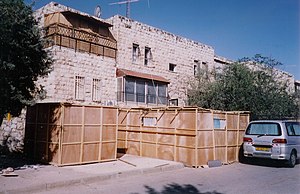I stayed at a beautiful and peaceful Carmelite monastery called Stella Maris. The Carmelite order was founded there by a group of Crusaders who decided to try to settle down and live as hermits in emulation of the Prophet Elijah who is said to have hidden in a cave. There are actually at least three different places in Haifa which are said to be Elijah's hiding place. Next to the monastery (and its guest house) is a church built around one such cave. There is a feeling of ancient reverence in this building constructed protectively over a small room of stone.
Much of my time in Haifa was spent in much more modern circumstances though. Spefically, Haifa provided a wide array of fascinating transportation options and I ended up more or less structuring my visit around riding around in as many different conveyances as possible. The grand total: a funicular, a cable car, three bus lines, a train ride to Tel Aviv, and finally, exhausted, a cab to my hotel.
Yes, Haifa has what I thought was a subway, but Alan corrected me and told me it was a funicular. It's called the Carmelit and it goes straight up the mountain. After buying my ticket and walking down lots of stairs to the platform, I initially got on it going the wrong way. I couldn't understand where to be to get on it going in the other direction until one of my fellow passengers explained that the cars run on the same tracks and you know which one to get on based on whether it's going uphill or downhill. Both the platforms and the train cars themselves are built to accomodate the slant of the hill. At each station, the platform is actually a series of platforms: a small platform and then some steps up and then another small platform, etc. And inside the cars the floors and seats are similarly stepped and built at what must be a reverse slant so that you are sitting straight up and down even though the train car itself is flush with the grade of the track. If this explanation is confusing, let me assure you that the feeling of riding on this contraption is somewhat disorienting as well. When I got off at the top, I felt as if I had "sea legs."
The monastery I stayed in is built on high hill overlooking the rest of the city and the bay below. Right across the street is a cable car (the kind that hangs in the air, not the kind on tracks) all the way down to the sea shore below. In Hebrew it's called a רכבל/rakebel which combines the words רכבת/rakevet/train and כבל/cable. This one has three small pods rather than a larger gondola.
 I rode in my own pod and got a kick out of its resemblance to the persimon I munched on at we zoomed down the side of the mountain. Here are some views.
I rode in my own pod and got a kick out of its resemblance to the persimon I munched on at we zoomed down the side of the mountain. Here are some views.

One of those tall buildings was my marker for the train station which I walked too after reaching the bottom.
At the train station, I bought my ticket and then rushed to the platform because I had been told the next train was coming in two minutes!
 But this is a picture of not-my-train...there were several of those that came first.
But this is a picture of not-my-train...there were several of those that came first.The train itself was very fast and very cheap (26.50 NIS or about 7 bucks).

But it was also very crowded, standing room only for part of the trip. Many of the passengers were young soldiers heading home for the weekend. Some found seats for themselves under the luggage rack.
I was sad not to be able to share these many modes of travel with Alan. He's much more a transportation buff than I am. In addition, while there are many wonderful and important lessons to be learned from traveling alone (e.g., the fact that both bouts of crankiness and moments of bliss can arise without any change in external circumstances whatsoever or the fact that one can actually use a public restroom without removing one's backpack), I feel I've spent enough time already learning these lessons and, having found such a wonderful traveling partner, would very much prefer to have his company.
And now I'm going to take a quick dip in the Med before shabbat comes in.

































